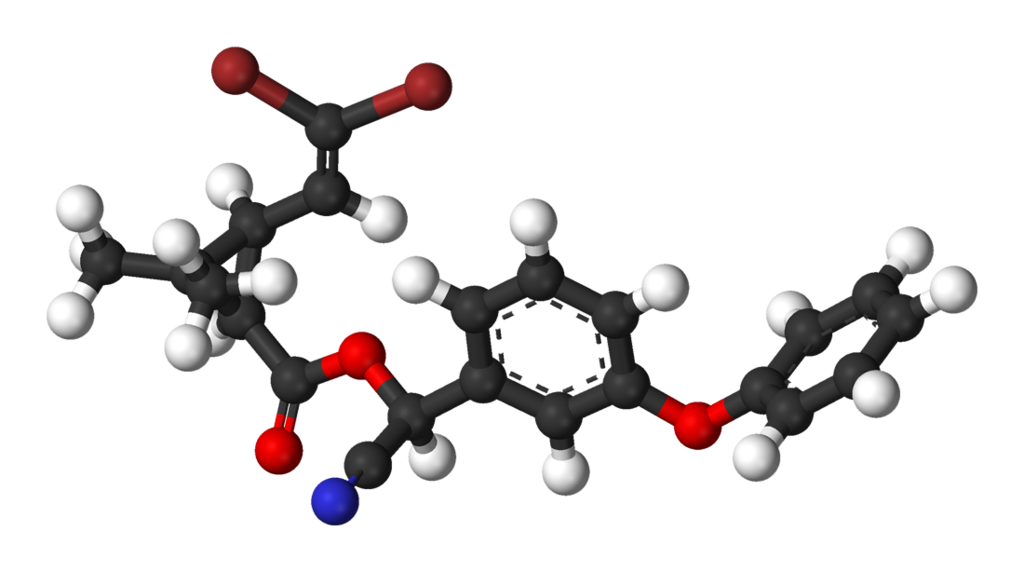Decamethrin

| |

| |
| Names | |
|---|---|
| IUPAC name
[(S)-Cyano-(3-phenoxyphenyl)-methyl] (1R,3R)-3-(2,2-dibromoethenyl)-2,2-dimethyl-cyclopropane-1-carboxylate
| |
| Other names
Deltamethrin
Decamethrin | |
| Identifiers | |
3D model (JSmol)
|
|
| ChEBI | |
| ChEMBL | |
| ChemSpider | |
| ECHA InfoCard | Lua error in Module:Wikidata at line 879: attempt to index field 'wikibase' (a nil value). Lua error in Module:Wikidata at line 879: attempt to index field 'wikibase' (a nil value). |
| KEGG | |
| UNII | |
| |
| |
| Properties | |
| C22H19Br2NO3 | |
| Molar mass | 505.21 g·mol−1 |
Except where otherwise noted, data are given for materials in their standard state (at 25 °C [77 °F], 100 kPa). | |
| Infobox references | |
|
WikiDoc Resources for Decamethrin |
|
Articles |
|---|
|
Most recent articles on Decamethrin Most cited articles on Decamethrin |
|
Media |
|
Powerpoint slides on Decamethrin |
|
Evidence Based Medicine |
|
Clinical Trials |
|
Ongoing Trials on Decamethrin at Clinical Trials.gov Clinical Trials on Decamethrin at Google
|
|
Guidelines / Policies / Govt |
|
US National Guidelines Clearinghouse on Decamethrin
|
|
Books |
|
News |
|
Commentary |
|
Definitions |
|
Patient Resources / Community |
|
Patient resources on Decamethrin Discussion groups on Decamethrin Patient Handouts on Decamethrin Directions to Hospitals Treating Decamethrin Risk calculators and risk factors for Decamethrin
|
|
Healthcare Provider Resources |
|
Causes & Risk Factors for Decamethrin |
|
Continuing Medical Education (CME) |
|
International |
|
|
|
Business |
|
Experimental / Informatics |
Editor-In-Chief: C. Michael Gibson, M.S., M.D. [1]
Overview
Deltamethrin is a pyrethroid ester insecticide.
Usage
Deltamethrin products are among the most popular and widely used insecticides in the world[citation needed] and have become very popular with pest control operators and individuals in the United States.[1] This material is a member of one of the safest classes of pesticides: synthetic pyrethroids. This pesticide is highly toxic to aquatic life, particularly fish, and therefore must be used with extreme caution around water. Although generally considered safe to use around humans, it is still neurotoxic to humans. Deltamethrin is able to pass from a woman's skin through her blood and into her breast milk.[2]
There are many uses for deltamethrin, ranging from agricultural uses to home pest control. Deltamethrin has been instrumental in preventing the spread of diseases carried by tick-infested prairie dogs, rodents and other burrowing animals[citation needed]. It is helpful in eliminating and preventing a wide variety of household pests, especially spiders, fleas, ticks, carpenter ants, carpenter bees, cockroaches and bed bugs. Deltamethrin is also one of the primary ingredients in ant chalk.
Production
Deltamethrin is a pyrethroid composed of a single stereoisomer, of a possible 8 stereoisomers, selectively prepared by the esterification of (1R,3R)- or cis-2,2-dimethyl-3-(2,2-dibromovinyl)cyclopropanecarboxylic acid with (alpha,S)- or (+)-alpha-cyano-3-phenoxybenzyl alcohol or by selective recrystallization of the racemic esters obtained by esterification of the (1R,3R)- or cis-acid with the racemic or (alpha-R, alpha-S, or alpha-R/S)- or + or − alcohol.
Malaria control
Deltamethrin plays key role in controlling malaria vectors, and is used in the manufacture of long-lasting insecticidal mosquito nets. It is used as one of a battery of pyrethroid insecticides in control of malarial vectors, particularly Anopheles gambiae, and whilst being the most employed pyrethroid insecticide, can be used in conjunction with, or as an alternative to, permethrin, cypermethrin and other organophosphate-based insecticides, such as malathion and fenthion. Resistance to deltamethrin (and its counterparts) is now extremely widespread and threatens the success of worldwide vector control programmes.
Resistance to deltamethrin
Resistance has been characterised in several insects, including important vectors of malaria like the mosquito Anopheles gambiae as well as non-disease carrying pests like bed bugs.
Mosquitoes
Methods of resistance include thickening of the cuticle of the insect to limit permeation of the insecticide, metabolic resistance via overexpression of metabolizing cytochrome P450 mono-oxygenases and glutathione-S-transferases, and the knockdown resistance (kdr) sodium channel mutations which render the action of insecticides ineffectual, even when co-administered with piperonyl butoxide. Characterization of the different forms of resistance among mosquitoes has become a top priority in groups studying tropical medicine due to the high mortality of those who reside in endemic areas.[3]
Bed bugs
Two mutations, the valine to leucine mutation (V419L) and the leucine to isoleucine mutation (L925I) in voltage-gated sodium channel α-subunit gene, have been identified as responsible for knockdown resistance to deltamethrin in bed bugs. One study found that 88% of bed bug populations in the US had one, the other, or both mutations, meaning that deltamethrin resistance among bed bugs is currently making this insecticide obsolete.[4]
Poisoning
In humans
Since deltamethrin is a neurotoxin, it temporarily attacks (in medical terms, "insults") the nervous system of any animal with which it comes into contact. Skin contact can lead to tingling or reddening of the skin local to the application. If taken in through the eyes or mouth, a common symptom is facial paraesthesia, which can feel like many different abnormal sensations, including burning, partial numbness, "pins and needles", skin crawling, etc. There are no reports indicating that chronic intoxication from pyrethroid insecticides causes motor neuron damage or motor neuron disease.[5]
Recently, in South Africa, residues of deltamethrin were found in breast milk, together with DDT, in an area that used DDT treatment for malaria control, as well as pyrethroids in small-scale agriculture.[6]
There are no antidotes, and treatment must be symptomatic, as approved by a physician. Over time, deltamethrin is metabolized, with a rapid loss of toxicity, and passed from the body. A poison control center should be contacted in the event of an accidental poisoning.
In domestic animals
Cases of toxicity have been observed in cattle following use of agricultural deltamethrin preparation in external application for tick control.[citation needed]
References
- ↑ "Deltamethrin Odorless Synthetic Pyrethroid Insecticides". PestProducts.com. Retrieved 2008-09-26.
- ↑ Bouwman, B. Sereda and H.M. Meinhardt, H.; B. Sereda and H.M. Meinhardt (December 2006). "Simultaneous presence of DDT and pyrethroid residues in human breast milk from a malaria endemic area in South Africa". Environmental Pollution. 144 (3): 902–917. doi:10.1016/j.envpol.2006.02.002. PMID 16564119. Retrieved 2008-09-26.
- ↑ Müller, Pie; Warr, Emma; Stevenson, Bradley J.; Pignatelli, Patricia M.; Morgan, John C.; Steven, Andrew; Yawson, Alexander E.; Mitchell, Sara N.; Ranson, Hilary; Hemingway, Janet; Paine, Mark J. I.; Donnelly, Martin J. (2008). "Field-Caught Permethrin-Resistant Anopheles gambiae Overexpress CYP6P3, a P450 That Metabolises Pyrethroids". PLoS Genetics. 4 (11): e1000286. doi:10.1371/journal.pgen.1000286. PMID 19043575.
- ↑ Template:Cite doi
- ↑ Doi, H.; Kikuchi, H.; Murai, H.; Kawano, Y.; Shigeto, H.; Ohyagi, Y.; Kira, J. (2006). "Motor neuron disorder simulating ALS induced by chronic inhalation of pyrethroid insecticides". Neurology. 67 (10): 1894. doi:10.1212/01.wnl.0000244489.65670.9f. PMID 17130437.
- ↑ Bouwman, B. Sereda and H.M. Meinhardt, H.; B. Sereda and H.M. Meinhardt (December 2006). "Simultaneous presence of DDT and pyrethroid residues in human breast milk from a malaria endemic area in South Africa". Environmental Pollution. 144 (3): 902–917. doi:10.1016/j.envpol.2006.02.002. PMID 16564119. Retrieved 2008-09-26.
External links
- Deltamethrin General Fact Sheet - National Pesticide Information Center
- Deltamethrin Technical Fact Sheet - National Pesticide Information Center
- Data Sheet on Pesticides No. 50 - IPCS INCHEM
- Pyrethrins and Pyrethroids Fact Sheet - National Pesticide Information Center
- Deltamethrin Pesticide Information Profile - Extension Toxicology Network
- Pages with script errors
- Chemicals without a PubChem CID
- Chemical articles with unknown parameter in Chembox
- Articles with changed EBI identifier
- ECHA InfoCard ID from Wikidata
- Articles containing unverified chemical infoboxes
- Chembox image size set
- All articles with unsourced statements
- Articles with unsourced statements from September 2008
- Articles with invalid date parameter in template
- Articles with unsourced statements from August 2009
- Articles with unsourced statements from February 2015
- Organobromides
- Phenol ethers
- Pyrethroids
- Insecticides
- Nitriles